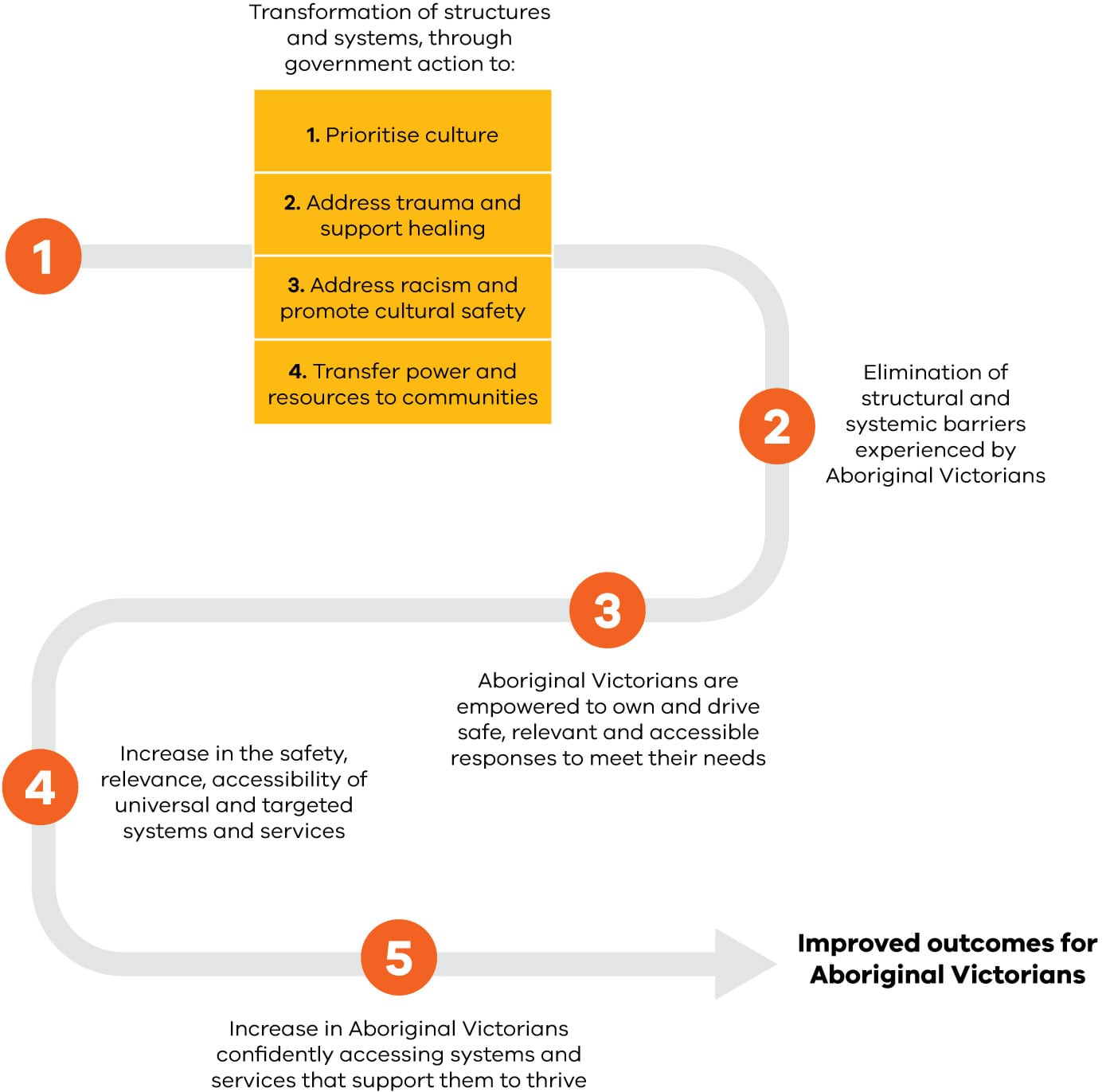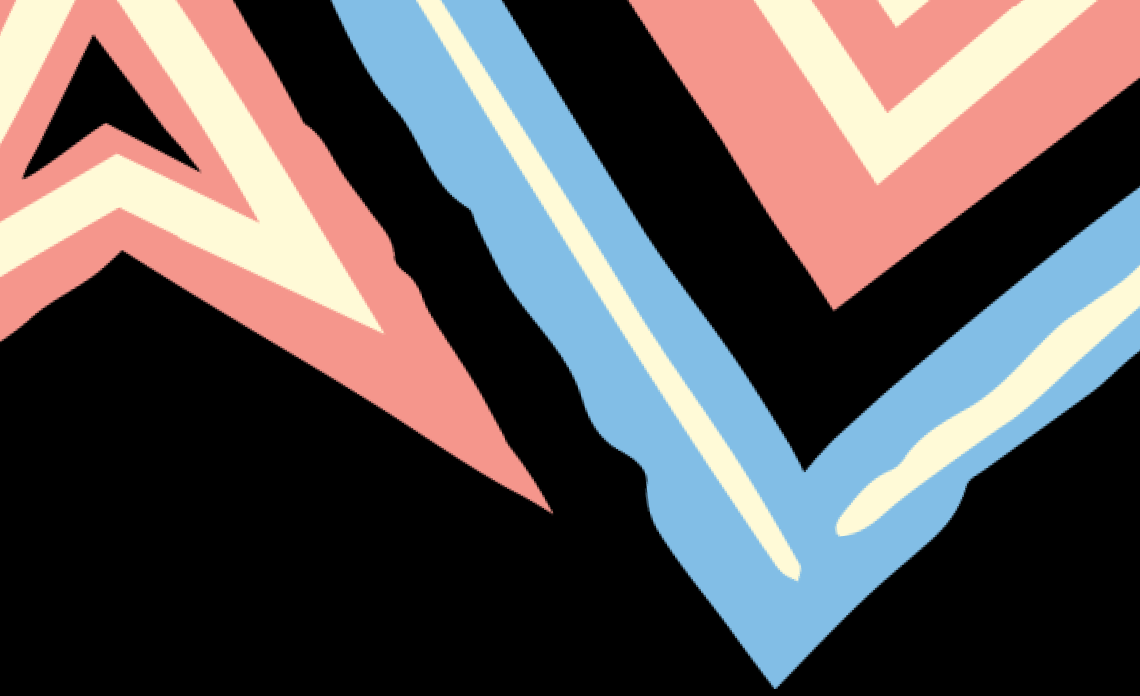Plan
The goals, objectives, measures and self-determination guiding principles and actions within the VAAF set a clear direction for how government will ‘Plan’, ‘Act’, ‘Measure’ and ‘Evaluate’ to progress change across government, address inequity and deliver stronger outcomes for and with Aboriginal Victorians.
Our purpose
The Victorian Aboriginal Affairs Framework 2018-2023 (the VAAF) provides an ambitious and forward-looking agenda for Aboriginal affairs. The VAAF has two key purposes:
- It is the Victorian Government’s overarching framework for working with Aboriginal Victorians, organisations and the wider community to drive action and improve outcomes
- It sets out whole of government self-determination enablers and principles, and commits government to significant structural and systemic transformation
Since 2006, Victoria has implemented whole-of-government frameworks to address the gaps between Aboriginal and non-Aboriginal Victorians. This has included the national Closing the Gap agenda since its commencement in 2008. These frameworks have reflected the Victorian context, including the unique voices, strength, resilience and cultural knowledge of Aboriginal people in Victoria.
Past government reporting in Aboriginal affairs focused on ‘how Aboriginal people are faring’. While this VAAF still has a focus on measuring improvements in people’s lives, it has transitioned to a new approach that enables community to hold government to account. The VAAF recognises that to achieve positive outcomes, we must fundamentally change the way governments work with Aboriginal people.
All community should have a voice: children, young people, Elders. - Community forum participant, Robinvale

Our shared vision
Our shared vision is that: ‘All Aboriginal Victorian people, families and communities are healthy, safe, resilient, thriving and living culturally rich lives.’
There has been significant investment and policy development contributing to strengthened cultural, economic, political and social outcomes for Aboriginal Victorians. Despite these efforts, much more needs to be done.
This vision acknowledges that Aboriginal aspiration extends beyond closing the gap towards long-term generational change and improved outcomes for all Victorian Aboriginal people, families and communities. It reflects our move away from just measuring life expectancy towards what Aboriginal people expect out of life.
We know that Aboriginal people know what is best for themselves, their families and their communities. Self-determination is the human right that underpins this vision and our collective efforts under the VAAF.
Self-determination makes you feel like you should be happy, safe and content to live where you want. For you to have access and be treated equitably, but also for your mob too. - Community forum participant, Lakes Entrance
The journey so far
Victoria is leading the way on self-determination by ensuring Aboriginal Victorians are at the heart of decision-making on the matters that affect their lives.
2018 marked ten years since the Commonwealth Government and state and territory governments signed the National Indigenous Reform Agreement (Closing the Gap). The Victorian Government has undertaken extensive community engagement across the state to understand community perspectives on the previous national Closing the Gap agenda and the VAAF to ensure that Victoria’s approach reflects Aboriginal voices.
More than 600 Aboriginal Victorians shared their wisdom and expertise on what the VAAF should look like. Open community forums and workshops were held throughout 2018 in 20 metro and regional communities across six regions: Loddon Mallee, Barwon South West, Gippsland, Grampians, Hume and Melbourne.
We heard from Elders, community members, Aboriginal organisations, mainstream services and government representatives. Conversations were held in a range of settings, including Aboriginal co-operatives, gathering places, community halls, sporting clubs and health services. There was a diversity of voices and experiences within the communities we visited, as well as common themes and aspirations.
In addition to the perspectives and voices of Aboriginal Victorians heard through community engagement, the VAAF builds on the reform and advocacy that has occurred in Aboriginal affairs and the contributions of generations of Victorian Aboriginal leaders.
The government needs to be accountable to respecting and really listening and tuning in to what the options are. - Community forum participant, Lakes Entrance
Some of the key milestones in Aboriginal affairs since 2006
2006
Peak Aboriginal and Torres Strait Islander and non‑Indigenous health bodies and human rights organisations join efforts as the National Indigenous Health Equality Campaign to advocate for Indigenous health equality. The Victorian Indigenous Affairs Framework is first developed in 2006 to provide a long-term, whole-of‑government, intergenerational strategy aimed at closing the gap between Aboriginal and non‑Aboriginal Victorians.September 2007
The United Nations Declaration on the Rights of Indigenous Peoples is adopted by the General Assembly, recognising the “urgent need to respect and promote the inherent rights of Indigenous peoples”. In April 2009, Australia formally endorses the Declaration.December 2007
The Council of Australian Governments (COAG) commits to ‘closing the gap’ in Aboriginal and Torres Strait Islander life expectancy.February 2008
Prime Minister Kevin Rudd delivers the National Apology to the Stolen Generations, apologising for the profound grief, suffering and loss caused by the removal of Aboriginal and Torres Strait Islander children from their families, communities and Country.March 2008
Victoria signs the Indigenous Health Equality Summit Statement of Intent, committing to work in partnership with Aboriginal and Torres Strait Islander people to achieve equality in health and life expectancy by 2030.November 2008
COAG agrees to the National Indigenous Reform Agreement, outlining the actions needed to achieve Closing the Gap targets in Indigenous disadvantage.August 2010
The Victorian Indigenous Affairs Framework 2010‑2013 outlines a plan to guide Victorian Government action to address the gaps between Aboriginal and non-Aboriginal Victorians.November 2012
The Victorian Government releases a strengthened Victorian Aboriginal Affairs Framework 2013-2018 to bring together government and Aboriginal community commitments and efforts in order to create a better future led by Aboriginal Victorians.March 2015
The Victorian Government commits to self-determination as the new policy framework to guide Aboriginal affairs in Victoria.May 2016
The call for treaty by Aboriginal Victorians is heard. The Victorian Government holds the first Victorian Treaty Forum to bring together Victoria’s Aboriginal communities and discuss how to advance self‑determination, a treaty and an Aboriginal representative body.June 2016
Aboriginal and Torres Strait Islander peak representative organisations from across Australia release the Redfern Statement, calling for a more just approach to Aboriginal and Torres Strait Islander Affairs and for the Commonwealth and state and territory governments to address unacceptable disadvantage experienced by First Peoples.May 2017
The Uluru Statement from the Heart, released by delegates of the First Nations National Constitutional Convention, calls for the establishment of a First Nations Voice enshrined in the Australian Constitution, and a Makarrata Commission to supervise an agreement making and truth-telling process between governments and First Nations.2018
COAG agrees to launch a refresh of Closing the Gap and considers new national targets. Victoria undertakes wide community engagement on the VAAF responding to the call from Aboriginal Victorians to further embed self‑determination within policy design and promote community-led priority setting.2018
The Victorian Treaty Advancement Commission is established to strengthen independence for Aboriginal Victorians on the pathway to treaty and ensure they remain at the heart of the process. In June 2018, Victoria passes Australia's first treaty legislation. The Advancing the Treaty Process with Aboriginal Victorians Act 2018 requires government to work with the Aboriginal Representative Body to establish the entities, rules and resource base necessary to support future treaty negotiations.
The VAAF complements existing strategies
Aboriginal communities and organisations are working in partnership with government to embed self-determination and improve outcomes across a range of government policies, strategies and reforms.
Across Victoria, there are many community-led and culturally responsive initiatives and strategies underway that embed Aboriginal self-determination, and strengthen the relationship between Aboriginal communities, Aboriginal organisations, mainstream organisations and government.
These strategies are about advancing Aboriginal self-determination and ensuring the voices of Aboriginal Victorians are at the heart of decision-making across policies, programs and practices throughout our state.
The VAAF links existing strategies
Rather than replacing or redirecting existing strategies, the VAAF provides the overarching whole-of-government framework to link this work. The VAAF acknowledges, aligns with and champions these existing initiatives and strategies.
As the overarching framework for Aboriginal affairs, the VAAF provides broad accountabilities for all areas of government, and provides a consistent foundation that complements the objectives and outcomes of existing strategies.
While existing strategies may have more detailed goals and specific targets related to their individual areas of accountability, the VAAF includes broad aspirational directions that work towards achieving equity of outcomes for Aboriginal Victorians.
The VAAF allows us to monitor progress and challenges across all areas of life
There are many different and complex factors that affect the lives of Aboriginal Victorians. These factors don’t exist in isolation – the realities and outcomes experienced in one part of a person’s life and identity influence the outcomes experienced in other aspects of their life.
The VAAF, and the Victorian Government, acknowledges the inter-relationship between outcomes, and sets goals and objectives across all areas of life. The VAAF also allows us to critically assess the diverse social structures and policies in place as well as the accessibility of services, acknowledging their impact on outcomes for individuals, families and communities.
Reporting against each of the VAAF’s goals and objectives will, over time, give us a clearer picture of the progress government and community are making in partnership across all areas of life for Aboriginal Victorians, as well as the challenges we still need to address.
The VAAF’s relationship with existing strategies
* The Advancing the Treaty Process with Aboriginal Victorians Act 2018 relates to all domain areas.
Updated

